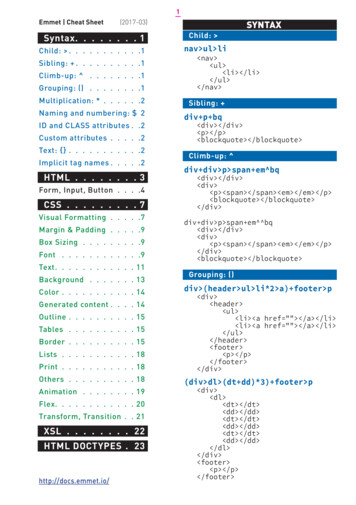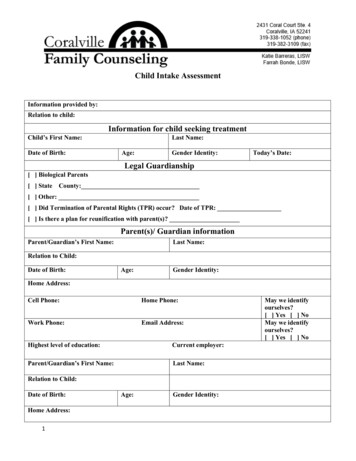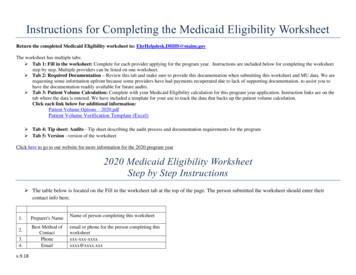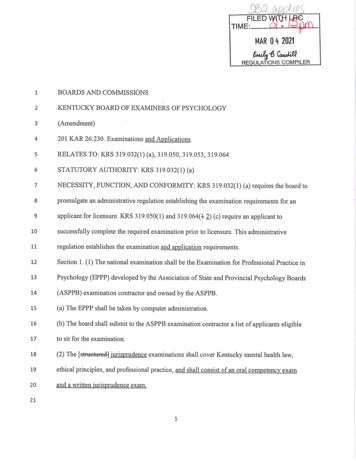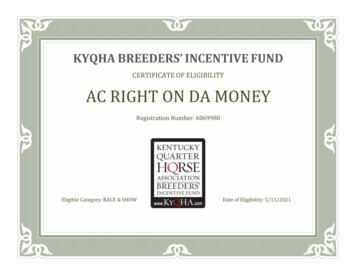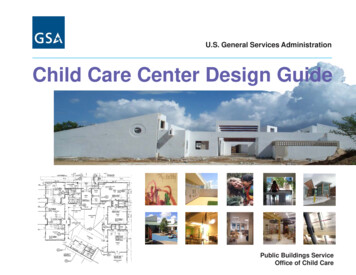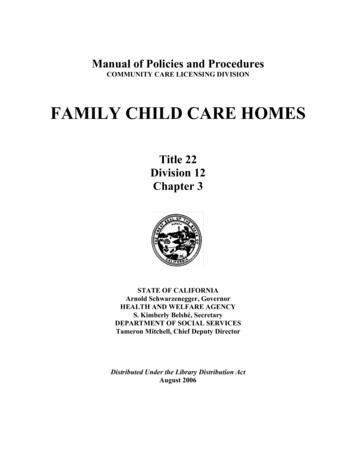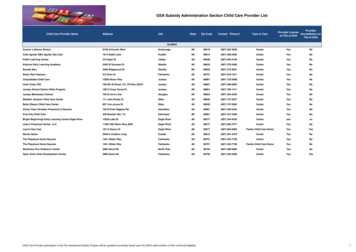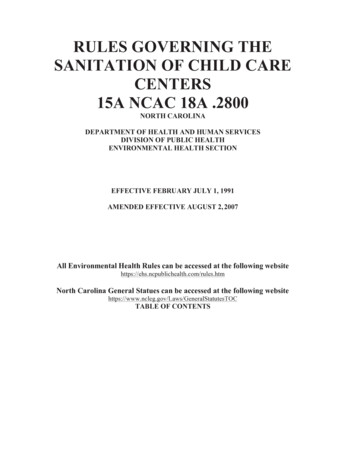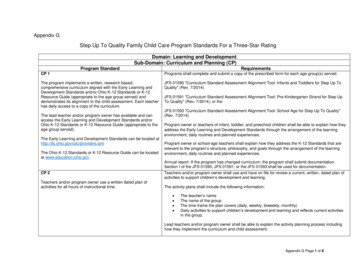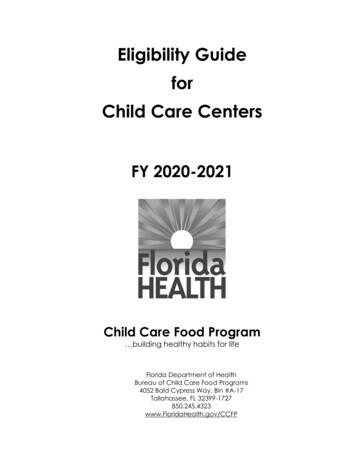
Transcription
Eligibility GuideforChild Care CentersFY 2020-2021Child Care Food Program building healthy habits for lifeFlorida Department of HealthBureau of Child Care Food Programs4052 Bald Cypress Way, Bin #A-17Tallahassee, FL 32399-1727850.245.4323www.FloridaHealth.gov/CCFP
In accordance with Federal civil rights law and U.S. Department of Agriculture (USDA) civil rights regulationsand policies, the USDA, its Agencies, offices, and employees, and institutions participating in or administeringUSDA programs are prohibited from discriminating based on race, color, national origin, sex, disability, age, orreprisal or retaliation for prior civil rights activity in any program or activity conducted or funded by USDA.Persons with disabilities who require alternative means of communication for program information (e.g. Braille,large print, audiotape, American Sign Language, etc.), should contact the Agency (State or local) where theyapplied for benefits. Individuals who are deaf, hard of hearing or have speech disabilities may contact USDAthrough the Federal Relay Service at (800) 877-8339. Additionally, program information may be madeavailable in languages other than English.To file a program complaint of discrimination, complete the USDA Program Discrimination Complaint Form,(AD-3027) found online at: http://www.ascr.usda.gov/complaint filing cust.html, and at any USDA office, orwrite a letter addressed to USDA and provide in the letter all of the information requested in the form. Torequest a copy of the complaint form, call (866) 632-9992. Submit your completed form or letter to USDA by:(1)mail: U.S. Department of AgricultureOffice of the Assistant Secretary for Civil Rights1400 Independence Avenue, SWWashington, D.C. 20250-9410;(2)fax: (202) 690-7442; or(3)email: program.intake@usda.gov.This institution is an equal opportunity provider.Revised 6/20201I-085-18
Child Care Food ProgramEligibility Guide for Child Care CentersTABLE OF CONTENTSPageIntroduction. . . . .3I.Definitions .4II.Determining Eligibility . .4III.Required Information from Applicants . 6IV.Determining Household Income .8V.Determining Household Size .9VI.Description of Forms Included in this Guide .10Forms (attached following page 10):Income Eligibility GuidelinesNews Release (Non-Pricing) – most centers use this News ReleaseNews Release (Pricing)Free and Reduced-Price Meal Application (English, Spanish, and Haitian-Creole) Standard version Combination version (includes Child Participation Information)Parent Letter (Non-Pricing) – (English, Spanish, and Haitian-Creole)Parent Letter (Pricing)Child Care Application for Enrollment (English, Spanish, and Haitian-Creole)Child Participation Form (English, Spanish, and Haitian-Creole)Enrollment Roster (August - July cycle and October - September cycle)Enrollment Roster Consolidation FormCollection Procedures for Pricing ProgramsRevised 6/20202I-085-18
INTRODUCTIONThe Child Care Food Program (CCFP) is a federally funded program that reimburses child care providers fornutritious meals and snacks served to eligible children. In Florida, the Department of Health (DOH), Bureau ofChild Care Food Programs, administers the CCFP.The purpose of this Eligibility Guide is to provide information on determining the eligibility of each child for freeor reduced-price meals. It is to be used by independent child care centers (including outside-school-hourscare centers) and sponsoring organizations of child care centers providing services under the CCFP.Sample forms and the current Income Eligibility Guidelines are included in this booklet; make copies ofthe forms as needed. These forms can also be accessed from the following locations listed below. Management Information and Payment System (MIPS)o Blank Forms/Documents on left menuCCFP website at tmlIn the CCFP, there are non-pricing programs and pricing programs. The most common is a non-pricingprogram in which the center does not charge separately for meals served. The other is a pricing program,which does charge separately for meals served.The CCFP State Office is located in Tallahassee; the phone number is 850.245.4323. Program Specialists arelocated in offices throughout the state; please refer to our website for contact information. Program Specialistsor someone from the State Office is available to answer your questions.Revised 6/20203I-085-18
I.DEFINITIONSThe following definitions may be helpful when reading this guidance.Enrolled child is a child whose parent or guardian has submitted a signed document to a child care center orsponsoring organization indicating that the child is enrolled for child care.Child means (a) a person 12 years of age and under; (b) a child of migrant workers 15 years of age and under;and (c) a person with an appropriately documented mental or physical disability who is enrolled in a child carecenter that serves a majority of persons 18 years of age and under.Free meal is a meal served under the CCFP to a child who meets one of the following criteria and hasappropriate verifying documentation: Member of a household that meets the income standards for free meals Member of a household receiving Temporary Assistance to Needy Families (TANF) or Food AssistanceProgram (also known as SNAP or Food Stamp Program) benefits Enrolled in Head Start or Early Head Start Enrolled in the Even Start Literacy Program and has not yet started kindergarten Foster children or children under temporary emergency placement by a court Homeless or institutionalized childrenReduced-Price meal is a meal served under the CCFP to a child from a household that meets the incomestandards for reduced-price meals.Non-needy meal is a meal served under the CCFP to a child from a family who does not meet the standardsfor either free or reduced-price meals.Non-pricing program means the child care center has no separate identifiable charge for meals served.Pricing program means the child care center has a separate identifiable charge for meals served. Pricingprograms are required to provide the same meals to children eligible for free or reduced-price meals as theyprovide to children who pay full price for meals.II.DETERMINING ELIGIBILITYIndependent child care centers (centers) and sponsoring organizations of child care centers (sponsors) thatparticipate in the CCFP must annually determine the eligibility of each enrolled child in order to claim free,reduced-price, or non-needy meals for reimbursement. The eligibility category determines the amount ofreimbursement.In most cases, a Free and Reduced-Price Meal Application (application) is used to collect householdinformation and determine a child’s eligibility category. There are certain situations when another officialdocument may be used in lieu of an application to determine eligibility; those exceptions are explained inSection III.B of this guide.The child care center must distribute the application and the instructions to the parents of newly enrolledchildren and children whose eligibility determination is expiring soon. The center must also distribute theaccompanying parent letter (both pages) or post a copy of the full letter in an area where parents can read itprior to completing the application. The parent letter provides important information and explains the reasonfor completing the application to the children’s parents.Revised 6/20204I-085-18
Any adult household member may complete and submit the application. The sponsor or center then reviewsthe application, compares the information to the income eligibility guidelines, and determines the child’seligibility category. A sponsor may allow its sponsored centers to determine the eligibility of the children;however, the sponsor is responsible for ensuring that each child’s eligibility is determined correctly.A child’s eligibility status, based on his/her approved application, lasts for one year from the month in which theeligibility determination was effective. Until a completed application (or other eligibility documentation) hasbeen approved by the center or sponsor, the child must be classified as eligible for non-needy meals. Centersor sponsors may choose to collect new applications on all currently enrolled children once a year, for examplein August or September.The information provided on the application is the household’s private information and the sponsor or centermust ensure that the information is kept confidential.The sponsor or center should delegate a staff member(s) to review and approve the applications and completethe Enrollment Roster. The delegated staff member(s) should review each application to determine anddocument eligibility by following these steps:1. Obtain from parent/guardian or other adult household member any missing information required todetermine eligibility. If obtaining missing information or clarifying information, note on the application thename of the household member you spoke to, the missing or clarified information, the date of contact, andyour initials.2. Review the application (or other eligibility documentation) to determine if the child is categorically eligiblefor free meals based on a Food Assistance Program or TANF case number, or documentation from HeadStart/Early Head Start, Even Start, Foster Care Agency, or Court. Refer to Section B on pages 6-7 forinformation on documents that can be accepted in lieu of Free and Reduced-Price Meal Applications incertain instances. If the child is not categorically eligible, then use the current Income Eligibility Guidelinesto determine the eligibility category of the child’s household.Note: If all income is reported in the same payment frequency (i.e., how often the income is received), donot convert to an annual amount because rounding of figures in the Income Eligibility Guidelines causesthe converted annual amount to be higher than the total of adding all the income together. Therefore,unnecessary income conversions may lead to incorrect classifications. When income paymentfrequencies are different, this is the only time you would convert all income to annual income, asnoted in the “For Contractor Use Only” section of the application.3. Complete the “For Contractor Use Only” section at the bottom of the application to indicate the eligibilitydetermination, then sign and date the form. Second party checks are optional, unless required as part of aCorrective Action Plan.4. Determine the effective date of eligibility using one of the options described in the CCFP policy memo fromApril 24, 2014, entitled “Effective Date of Income Eligibility Determinations.” This memo can be found in theCCFP’s Management Information and Payment System (MIPS) under the Policy Memos link, Fiscal Year2014.5. File all applications (including those for children no longer enrolled) in alphabetical order or preferably in anorder to match the Enrollment Roster. For a child no longer enrolled, note the child’s withdrawal date onthe Enrollment Roster.6. For children whose eligibility was determined based on documentation from Head Start/Early Head Start,Even Start, Foster Care Agency, or a Court, keep those documents on file with the Free and ReducedPrice Meal Applications for the other children.7. Complete the Enrollment Roster and update it throughout the year as changes occur.Revised 6/20205I-085-18
Eligibility information does not have to be verified. However, verification of information is allowed when basedupon some reasonable cause for suspicion. This verification must be performed in a non-discriminatorymanner. Refer to Chapter 2 of your procedure manual for more detailed eligibility information.III.REQUIRED INFORMATION FROM APPLICANTSA. Information Required on the Free and Reduced-Price Meal ApplicationType ofHouseholdFood AssistanceProgram (alsoknown as SNAPor Food StampProgram)or TANF(TemporaryAssistance toNeedy Families)Required Information(Additional information may be provided but is not required to determine eligibility category.)1. Name of child.2. Food Assistance Program or TANF Case Number. This is a 10-digit numberassigned to the household receiving benefits. This number typically begins with a“1” and is on the “notice of decision” or “letter of eligibility” provided by the FoodAssistance Program/TANF Office. It is not the 16-digit random number on theelectronic benefits card used for the program. Note: Medicaid and subsidizedchild care eligibility does not automatically qualify children for free meals.3. Signature of parent/guardian or other adult household member.NOTE: If any member of the household currently receives Food AssistanceProgram or TANF benefits, then any child in that household is eligible for free meals.Foster Child(if document fromfoster careagency or court isnot submitted)1. Name of child.All OtherHouseholds1. Name of child.2. Circled Yes answer in the appropriate row of the foster child column.3. Signature of foster parent/guardian or other adult household member.2. All household member names (children and adults).3. Combined gross income for all household children (through age 18) who haveany income, and how often that income is received. If the children’s incomesection (Step 3.A) is blank, you can assume there is no children’s income.4. Current gross income (or net income for self-employed persons only) from allsources for each adult household member and how often each source of incomeis received. (Note: For any adult household member that does not receive anyincome, “none” or “0” should be listed for that person. If an adult has no incomelisted, you can assume his/her income is “none” or “0”, and the application can beapproved accordingly with no income for that individual. If there are no adultslisted in Step 3.B, the application is incomplete and you cannot consider it to be azero income application.)5. Signature of parent/guardian or other adult household member.6. The last four digits of the social security number of the adult household memberthat signed the form. If this person does not have a social security number, then“none” must be written in the spaces provided.Revised 6/20206I-085-18
B. Documents Accepted in Lieu of a Free and Reduced-Price Meal ApplicationFoster Children or Children Placed Temporarily by a Court are automatically eligible for the free mealeligibility category with official documentation from the foster care agency or court that placed the child. Withsuch documentation, a Free and Reduced-Price Meal Application is not required.Head Start and Early Head Start participants are automatically eligible for the free meal eligibility category.Proof of Head Start enrollment must be established by obtaining, and maintaining on file, one of the followingdocuments: A child’s approved Head Start/Early Head Start application for enrollment A signed and dated document from the Head Start/Early Head Start Program Office that includes achild’s name, or a list of children’s names, and the date of enrollment in Head Start for the child(ren)Once on file, the above documents remain valid for as long as the child remains enrolled in theapplicable program.If Head Start/Early Head Start documentation is not available, then the household must submit a Free andReduced-Price Meal Application, and eligibility would be determined in the traditional manner.Even Start Family Literacy Program participants are automatically eligible for free meals if they are enrolledin the Even Start Program and are not yet in kindergarten. Proof of Even Start enrollment must be establishedby obtaining, and maintaining on file, one of the following documents: An approved Even Start Program Application with confirmation that the child has not yet enteredkindergarten Statement of enrollment for the Even Start Program with confirmation that the child has not yet enteredkindergarten A list of children's names confirming that the children are currently enrolled as participants in the Even StartProgram and that the children have not yet entered kindergartenNote: To be valid, each of the eligibility documents listed above must include a signature and date of signatureof the local project director or an individual authorized to provide certification on behalf of the Even StartProgram.At the beginning of each school year, the eligibility determination official must re-establish the categoricaleligibility for each Even Start child.If none of the Even Start documents are available, then the household must submit a Free and Reduced-PriceMeal Application, and eligibility would be determined in the traditional manner.C. Applications for Homeless Children or Children in a Residential Child Care Institution(RCCI)For homeless children whose parents or guardians fail to complete and return a Free and Reduced-PriceMeal Application, the following procedures are acceptable: The director of the homeless shelter where the child lives may complete and return an application for thechild. Local officials, such as social service agency employees, public school principals, etc., may complete andreturn an application for a homeless child based solely on their knowledge that the child’s address is ahomeless shelter or that the child has no known address and is indeed homeless.Revised 6/20207I-085-18
For children in a RCCI, the parent, guardian, director or an authorized employee of the residential facility inwhich the child resides must sign the application and include the child’s name and the facility name.IV.DETERMINING HOUSEHOLD INCOMECurrent Household Income: This term refers to the current amount of income each person usually receives(before deductions for taxes, social security, etc.), how often it is received, and where it is from, such aswages, retirement, or public assistance. If self-employed, the net income should be listed. Net income isdefined as gross receipts less operating expenses. If income frequency is not listed, the center or sponsormust contact the household to find out how often the income is received and document this information. Thecenter or sponsor must not assume that the income is received monthly.Income: The total monetary compensation of a household before any deductions such as income taxes,social security taxes, insurance premiums, charitable contributions and savings bonds.Income includes: Monetary compensation for services, including wages, salary, commissions or fees Net income from self-employment Social security payments Dividends or interest on savings, bonds, stocks or income from estates or trusts Net rental income Public assistance payments (see below for certain exclusions) Unemployment compensation Retirement benefits, pensions, annuities or veteran’s payments Alimony or child support payments Regular contributions from persons not living in the household Net royalties Other cash income. This includes cash amounts received or withdrawn from any source including savings,investments, trust accounts and other resources, which would be available to pay the price of meals. Military benefits received in cash, such as off-base commercial/private housing allowances for militaryhouseholds living off base, food, and/or clothing allowances, must be considered as income. Theexceptions to this are the Military Housing Privatization Initiative, Family Subsistence SupplementalAllowance and, in certain circumstances, combat pay. See below.Some income exclusions are: Benefits received through the Food Assistance Program (also known as SNAP or Food Stamp Program),TANF, Child Care Development Block Grant, or National School Lunch/Breakfast Programs Military Housing Privatization Initiative: This housing benefit, in the form of cash, is not considered income.A housing allowance will appear on the leave and earnings statement of service memb
The Child Care Food Program (CCFP) is a federally funded program that reimburses child care providers for . (MIPS) under the Policy Memos link, Fiscal Year 2014. 5. File all applications (including those for children no longer enrolled) in alphabetical order or preferably in an
